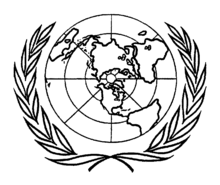Flag of the United Nations
The emblem on the flag is coloured white; it is a depiction of the world map in the azimuthal equidistant projection (centred on the North Pole and the International Date Line), surrounded by a pair of olive branches.The emblem depicts a azimuthal equidistant projection of the world map, centred on the North Pole, with the globe being orientated to the International Date Line.The azimuthal equidistant projection used in his design was heavily influenced by the maps created during World War II by Richard Edes Harrison, a popular cartographer working for Fortune and Life.[6][7].The blue that appears in the background of the insignia was chosen to be "the opposite of red, the war colour",[8] although the exact shade has never been officially specified by the United Nations.According to official explanations, the change was made to represent countries "as far as possible in their proper relationship to the cardinal points"[1] and "so the east and west were in balance".



 The "
United Nations Honour Flag
", used as a symbol of the wartime allies,
c.
1943–1948
The "
United Nations Honour Flag
", used as a symbol of the wartime allies,
c.
1943–1948
azimuthal equidistant projectionolive branchesDonal McLaughlinUnited NationsNorth PoleInternational Date Linelaurelsky bluebranches of the olive treeaspect ratioUnited Nations Charter100° Westprime meridianUnited Nations Honour FlagUnited Nations Conference on International OrganizationSan Francisco, CaliforniaUnited States Secretary of StateEdward Stettinius, Jr.Oliver LundquistOffice of Strategic ServicesWorld War IIRichard Edes HarrisonFortuneazimuthal projectionSouthern HemisphereRand McNallyConvention on the Safety of United Nations and Associated Personnelpeacekeepingprotective signarmed conflictInternational Atomic Energy AgencyBohr modelBerylliumInternational Civil Aviation Organizationpilot's wingsInternational Labour OrganizationInternational Maritime OrganizationInternational Telecommunication UnionUnited Nations Educational, Scientific and Cultural OrganizationGreek templeParthenonUnited Nations Children's FundUniversal Postal UnionWorld Food ProgrammeWorld Health OrganizationRod of AsclepiusWorld Meteorological Organizationcompass roseInternational Criminal CourtfamilyUnited Nations trust territoriesBosnia and Herzegovinaflag of Bosnia and Herzegovinaflag of EuropeCambodiaflag of the United Nations Transitional Authority in CambodiaKhmer scriptCyprusflag of CyprusEritreaflag of EritreaFederated States of Micronesiaflag of the Federated States of Micronesiaflag of the Trust Territory of the Pacific IslandsKosovoflag of KosovoNorthern Mariana Islandsflag of the Northern Mariana IslandsSomaliaflag of SomaliaUnited Nations Trust Territory of SomalilandTrust Territory of the Pacific IslandsTurkmenistanFlag of TurkmenistanKosraePohnpei StateChuuk StateYap StateU, Federated States of MicronesiaUN Secretary-GeneralDag HammarskjöldSweden'sFlag of EarthHymn to the United NationsThe New York TimesWayback MachineUnited Nations AssociationFlags of the WorldSecretary-GeneralAntónio GuterresDeputy Secretary-GeneralAmina J. MohammedGeneral Assembly President Dennis FrancisUN SystemCharterPreambleSecretariatselectionsUnder-Secretary-GeneralGeneral AssemblyPresidentInternational Court of JusticeStatuteSecurity CouncilElectionsMembersReformVeto powerEconomic and Social CouncilTrusteeship CouncilCulture of PeaceMINURSOUNAIDSUNCITRALUNCTADOzonActionUNEP/GRID-ArendalUNEP-WCMCUN-HABITATUNICEFUNICRIUNIDIRUNITARUN-OceansUNOSAT